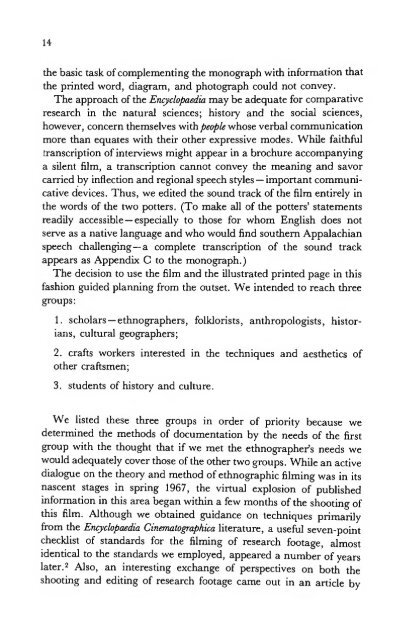Smithsonian Contributions - Smithsonian Institution Libraries
Smithsonian Contributions - Smithsonian Institution Libraries
Smithsonian Contributions - Smithsonian Institution Libraries
Create successful ePaper yourself
Turn your PDF publications into a flip-book with our unique Google optimized e-Paper software.
14<br />
the basic task of complementing the monograph with information diat<br />
the printed word, diagram, and photograph could not convey.<br />
The approach of the Encyclopaedia may be adequate for comparative<br />
research in the natural sciences; history and the social sciences,<br />
however, concern themselves with people whose verbal communication<br />
more than equates with their other expressive modes. While faithful<br />
transcription of interviews might appear in a brochure accompanying<br />
a silent film, a transcription cannot convey the meaning and savor<br />
carried by inflection and regional speech styles — important communicative<br />
devices. Thus, we edited the sound track of the film entirely in<br />
the words of the two potters. (To make all of the potters' statements<br />
readily accessible —especially to those for whom English does not<br />
serve as a native language and who would find southern Appalachian<br />
speech challenging—a complete transcription of the sound track<br />
appears as Appendix C to the monograph.)<br />
The decision to use the film and the illustrated printed page in this<br />
fashion guided planning from the outset. We intended to reach three<br />
groups:<br />
1. scholars —ethnographers, folklorists, anthropologists, historians,<br />
cultural geographers;<br />
2. crafts workers interested in the techniques and aesthetics of<br />
other craftsmen;<br />
3. students of history and culture.<br />
We listed these three groups in order of priority because we<br />
determined the methods of documentation by the needs of the first<br />
group with the thought that if we met the ethnographer's needs we<br />
would adequately cover those of the other two groups. While an active<br />
dialogue on the theory and method of ethnographic filming was in its<br />
nascent stages in spring 1967, the virtual explosion of published<br />
information in this area began within a few months of the shooting of<br />
this film. Although we obtained guidance on techniques primarily<br />
from the Encyclopaedia Cinematographica literature, a useful seven-point<br />
checklist of standards for the filming of research footage, almost<br />
identical to the standards we employed, appeared a number of years<br />
later. 2 Also, an interesting exchange of perspectives on both the<br />
shooting and editing of research footage came out in an article by

















